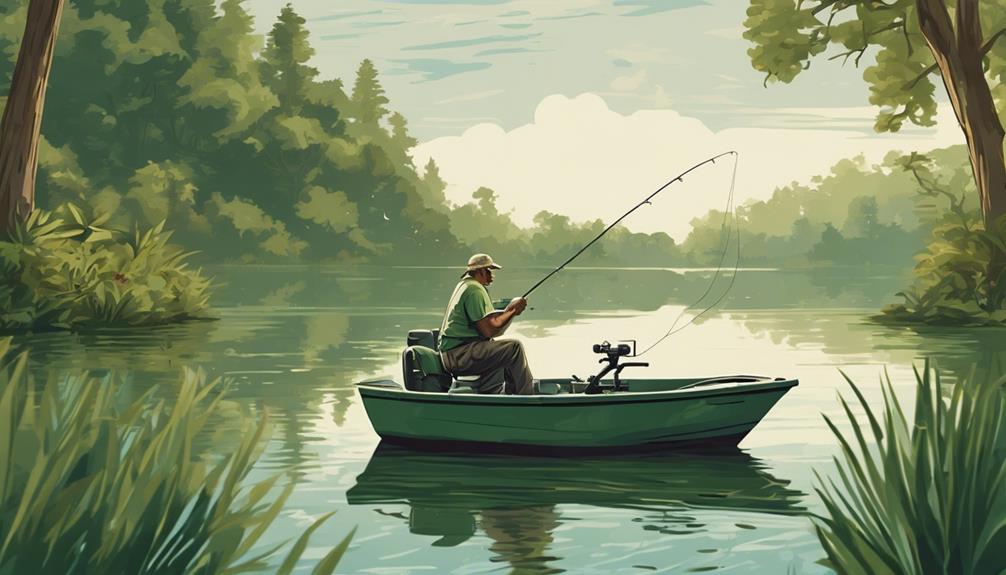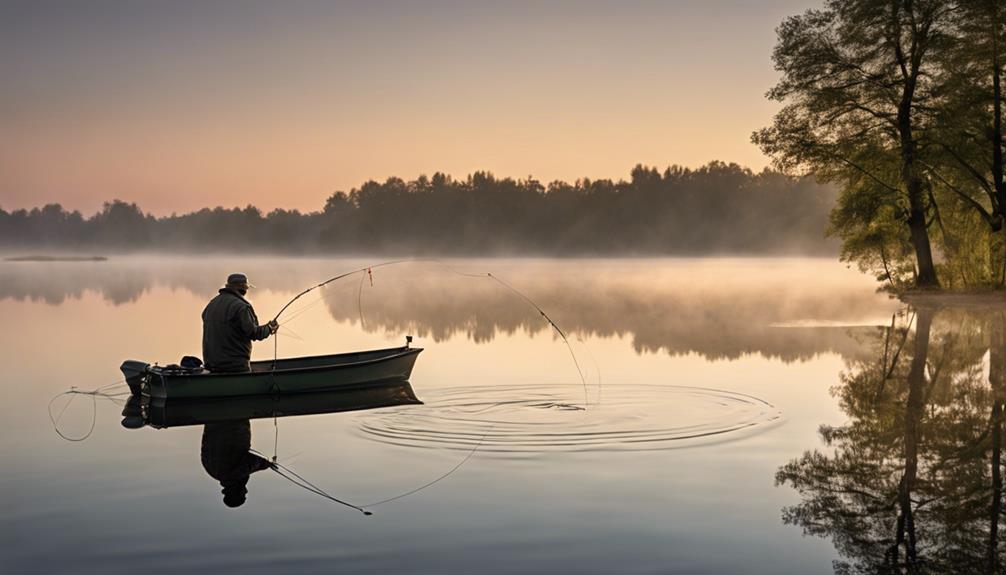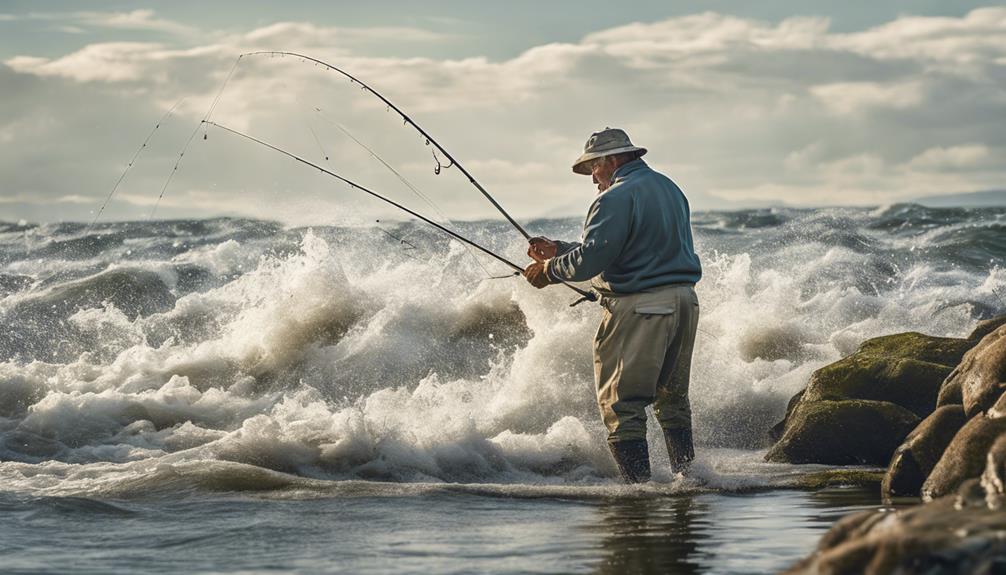When it comes to targeting large mouth bass, one crucial aspect to consider is the time of day you choose to fish. Early mornings and late evenings are typically the prime times for bass activity, but have you ever wondered what makes these periods so special for bass anglers?
Understanding the science behind bass feeding behaviors during these times can significantly boost your chances of landing a trophy fish. So, what exactly happens beneath the surface that makes dawn and dusk the most opportune moments for reeling in a lunker?
Choosing the Right Equipment
When gearing up for large mouth bass fishing, selecting the right equipment is crucial for a successful and enjoyable fishing experience. Proper rod selection is key; choose a rod that's medium to medium-heavy with a fast action tip for sensitivity. This type of rod allows you to feel the bass bite and set the hook quickly. Ensure your reel is well-maintained by regularly oiling the bearings and gears to keep it functioning smoothly.
Equipment maintenance is equally important. Clean your gear after each use, especially if you fish in saltwater environments where corrosion can occur quickly. Make sure to rinse rods, reels, and lures with fresh water and dry them thoroughly to prevent rust. Organizing your gear is essential for efficiency on the water. Invest in tackle boxes or bags with compartments to keep your lures, hooks, weights, and tools neatly arranged.
Understanding Bass Behavior
To better target large mouth bass while fishing, understanding their behavior is essential for increasing your chances of a successful catch. Large mouth bass have distinct feeding patterns that vary depending on the time of day and water temperature. They're most active during dawn and dusk when they tend to feed closer to the shore. In warmer months, bass often move into shallower waters to hunt for prey, while in colder months, they may head to deeper waters.
Understanding bass spawning habits is crucial for conservation and to avoid disturbing their breeding grounds. Bass typically spawn in the spring when water temperatures range between 60-75°F. During this time, they construct nests in shallow waters near the shoreline, making them vulnerable to fishing pressure.
Knowing bass hiding spots is key to locating them in different environments. Bass often seek cover in structures like submerged logs, aquatic vegetation, or rock formations. These hiding spots provide shelter and ambush points for bass to prey on smaller fish.
Migration routes are essential to consider when targeting bass throughout the year. Bass migrate between deep and shallow waters based on the seasons and water temperature changes. By understanding these patterns, you can increase your chances of locating bass in different areas effectively.
Mastering the Art of Casting
Ready to level up your fishing game? Mastering the art of casting is essential for targeting large mouth bass effectively. To improve accuracy, practice your casting technique regularly. Start by gripping the rod comfortably and keeping your wrist firm. When casting, smoothly accelerate the rod forward and release the line at the right moment to achieve a precise landing spot. Adjusting distance is crucial when fishing for large mouth bass. By mastering different casting techniques like flipping, pitching, and overhead casting, you can reach various distances and target specific areas where bass are likely to hide.
To improve accuracy, focus on your target and visualize where you want your bait to land. Practice in different conditions to adjust to wind and other environmental factors that can affect your casting. Additionally, try using markers on the shore to gauge your distance and improve your consistency. Adjusting distance isn't only about how far you cast but also about placing your bait near underwater structures or vegetation where bass tend to gather. Experiment with different casting angles and distances to find the sweet spot where you get the most bites.
Using the Right Bait
Mastering the art of casting is crucial for effectively using the right bait when targeting large mouth bass. To maximize your chances of a successful catch, pay close attention to bait selection and lure presentation.
- Bait Selection
- Choose bait based on the conditions of the waterbody and the time of day.
- Opt for live bait such as minnows or worms for a more natural presentation.
- Experiment with artificial baits like crankbaits or plastic worms to see what the bass are responding to.
- Consider the size and color of the bait to match the local forage and increase your chances of a strike.
- Lure Presentation
- Practice varying retrieval speeds to find the most effective technique for the day.
- Pay attention to the depth at which the bass are biting and adjust your presentation accordingly.
- Use a combination of twitching, pausing, and reeling to mimic the movement of prey.
- Focus on presenting the bait near structures where bass are likely to hide, such as rocks, fallen trees, or weed beds.
Practicing Patience and Persistence
Being patient and persistent is key when it comes to honing your skills in large mouth bass fishing. Developing techniques takes time and effort, so don't get discouraged if you don't see immediate results. Large mouth bass can be elusive, requiring you to adapt and refine your approach continuously. Patience is crucial as you learn the behavior of the fish and the best ways to attract them. By staying persistent and not giving up easily, you'll gradually improve your fishing abilities.
Managing frustration is a common challenge in large mouth bass fishing. There will be days when the fish aren't biting, or you might lose a big catch. It's essential to stay calm and focused during these times. Remember that each fishing trip, successful or not, is an opportunity to learn and grow. Use moments of frustration as motivation to enhance your skills and try new techniques.
Experiment with different lures, baits, and casting techniques to see what works best in various conditions. Take note of what's effective and adjust your strategy accordingly. The process of refining your skills is ongoing, so embrace the journey and enjoy the learning experience. With patience and persistence, you'll become a more successful large mouth bass angler.
Exploring Different Fishing Locations
To enhance your large mouth bass fishing skills, consider exploring different fishing locations to increase your chances of a successful catch. When it comes to targeting large mouth bass, the location plays a crucial role in determining your fishing experience. Here are some key points to keep in mind as you venture into different fishing locations:
- Lake versus river fishing: Lakes and rivers offer unique environments for bass fishing. Lakes tend to have more stable water conditions and can provide abundant cover for bass to hide. On the other hand, rivers have moving water that can lead to more active feeding behaviors in bass. Exploring both lake and river fishing spots can help you understand the preferences of large mouth bass in different settings.
- Deep sea exploration: While large mouth bass are typically associated with freshwater bodies, exploring deep-sea fishing locations can also be rewarding. Some coastal areas and offshore spots offer opportunities to catch large mouth bass in saltwater environments. Deep sea exploration can add a new dimension to your fishing adventures and introduce you to a different kind of bass fishing experience.
Learning to Set the Hook Properly

Ensure that your hook is set properly to maximize your chances of successfully landing a large mouth bass. Improving your technique when setting the hook is crucial for increasing your hooking success. To achieve this, it's essential to understand the right timing and motion required to securely hook the bass.
When you feel a bite, resist the urge to immediately jerk your rod. Instead, wait for a slight delay to ensure the fish has properly taken the bait. Once you feel the weight of the fish on the line, swiftly but firmly jerk the rod upwards. This motion should be quick and decisive, aiming to drive the hook into the bass's mouth.
Practice is key when it comes to setting the hook correctly. Spend time honing your technique, paying attention to the feedback you receive from each hook set. Adjust your timing and strength based on how the bass react to ensure a higher hooking success rate.
Remember that setting the hook too softly may result in the fish spitting out the bait, while setting it too aggressively could lead to the hook being ripped out of the bass's mouth. Finding the right balance through practice and observation will significantly improve your hooking success when targeting large mouth bass.
Adapting to Changing Conditions
Understanding how to adapt to changing conditions is vital for consistently catching large mouth bass. When you're out on the water, being able to adjust your techniques based on the environment can make all the difference in your fishing success. Here are some key points to keep in mind:
- Weather patterns, Adaptation techniques: Pay close attention to the weather forecast before heading out. Bass behavior can change significantly based on weather conditions. If it's a sunny day, bass might move to deeper waters, so consider using deeper diving lures. On overcast days, bass may be more active near the surface, making topwater lures a great choice.
- Water conditions, Flexibility strategies: Keep an eye on the water conditions as they can impact bass behavior. If the water is clear, using natural-colored lures can be effective. In murky water, opt for brighter colored lures that can grab the bass's attention. Additionally, if you notice a sudden change in water temperature, try varying your retrieval speed to see what works best.
Frequently Asked Questions
How Can I Effectively Locate Large Mouth Bass in Murky or Stained Water Conditions?
When fishing in murky or stained water conditions, you'll want to focus on lure selection and techniques that cater to the bass's senses. Look for structure like submerged vegetation or fallen trees where bass might hide.
Patience is key as you may need to try different lures and presentations to entice the fish. By understanding their environment and adjusting your approach, you can increase your chances of locating large mouth bass successfully.
What Are Some Tips for Fishing in Heavily Vegetated Areas Where Bass Tend to Hide?
When fishing in heavily vegetated areas where bass like to hide, it's essential to focus on lure selection and stealth techniques.
To navigate through vegetation effectively, work on your casting accuracy. Choose lures that can maneuver through the plants without getting snagged, and approach the area quietly to avoid spooking the fish.
Are There Any Specific Techniques for Targeting Trophy-Sized Bass Versus Smaller Bass?
When going after trophy-sized bass versus smaller ones, your focus should shift to lure selection and presentation. Understanding seasonal patterns and behavior can help you target the bigger fish.
Experiment with different lures that mimic larger prey to entice trophy bass. Adjust your presentation to match the aggressiveness of these larger predators.
How Can I Adjust My Fishing Strategy When Faced With Unexpected Weather Changes During a Fishing Trip?
When faced with unexpected weather changes during a fishing trip, adjust your strategy by considering tackle selection and weather patterns.
Choose appropriate bait presentation based on water clarity.
Be flexible and adapt to the conditions by using different lures or adjusting your fishing spot.
Stay observant and ready to switch things up to increase your chances of a successful catch despite changing weather.
What Are Some Common Mistakes That Beginner Anglers Make When Targeting Large Mouth Bass, and How Can They Be Avoided?
When targeting large mouth bass, beginners often make mistakes like using the wrong bait and casting technique. To avoid these errors, focus on proper bait selection and casting techniques.
Remember, patience is key in fishing; rushing may lead to missed opportunities. Additionally, handle the fish properly to ensure their well-being.
Conclusion
So, remember to keep these strategies in mind next time you head out for some large mouth bass fishing.
By choosing the right equipment, understanding bass behavior, mastering casting, using the right bait, being patient and persistent, exploring different locations, setting the hook properly, and adapting to changing conditions, you'll increase your chances of reeling in a big one.
Happy fishing!



